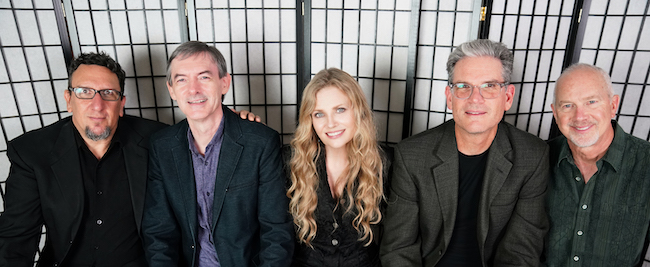Oct 28, 2025 10:47 AM
In Memoriam: Jack DeJohnette, 1942–2025
Jack DeJohnette, a bold and resourceful drummer and NEA Jazz Master who forged a unique vocabulary on the kit over his…

The Tierney Sutton Band includes Kevin Axt (left), Christian Jacob, Sutton, Trey Henry and Ray Brinker.
(Photo: scottmitchellphotography.smugmug.com ©2019)Suburban neighborhood Studio City is on the business end of the Hollywood machine, more likely to be bustling at 7 a.m. than 7 p.m., but there’s the occasional lively corner—if you know where to look. Located up a set of stairs and down a hallway, Feinstein’s at Vitello’s is a venue that frequently features cabaret or comedy. In front of a packed house on June 24, the Tierney Sutton Band celebrated the release of its latest album, ScreenPlay (BFM jazz), an homage to the songs of cinema.
“Often my response to seeing jazz concerts is that I feel a lot of testosterone,” said vocalist Sutton, following a set of film-related standards, new and old. “‘OK, you can play. That’s great. Now what happens?’ With that energy, it’s not a conversation anymore. It’s a loud monologue with no feedback, and I get really weary of that.”
The Tierney Sutton Band has been together for 27 years and moves as a whole, members using a shorthand language formed through thousands of hours spent together.
“They are crazy virtuosos. I do my best to keep up,” Sutton joked. “The way that we arrange is in a way that exposes everybody. We try to have precision. It’s a matter of what you hone over the years. We’re always challenging ourselves to do something that keeps you on the edge.”
In 2015, the band gained a prominent new fan; during a run of Hollywood shows, actor/director Clint Eastwood was in attendance on multiple nights. It’s not uncommon to see Eastwood standing tall in any California jazz room, but two consecutive nights is something to notice. By the end of the week, all involved were colleagues.
Eastwood invited Sutton and pianist Christian Jacob to see a rough cut of his work-in-progress, Sully, the Tom Hanks-led biopic about pilot Chesley Sullenberger. Eastwood wanted the band to record a soundtrack for the film, and with little fanfare Sutton and company were in the studio that weekend, recording for two days with Eastwood present for nearly the entire time.
ScreenPlay features songs used in the film, as well as five tunes penned by Alan and Marilyn Bergman. A crowd-pleasing rendition of “If I Only Had A Brain” (from the Wizard of Oz) features bassists Kevin Axt and Trey Henry swaggering in tandem, a pizzicato bass stabbing over a funky electric riff. The use of two basses is one of TSB’s hallmarks.
“It’s seamless,” Sutton said of the passage. “They are incredibly united. ... It’s hard to explain, but it adds so much.”
The musicians’ commitment to unity was evident at Feinstein’s. Each instrumentalist throughout the night showed flashes of greatness, but never commanded the spotlight.
“Nobody plays better than my band, but they show restraint,” Sutton said. “They are masters of serving the music. The feeling of singing with my band and how they’re listening is such a tangible thing that if I sing in other situations with less sensitive players, I feel teary and upset. ... I’m [the princess in] ‘The Princess and the Pea’ after playing with these guys.” DB

Jack DeJohnette boasted a musical resume that was as long as it was fearsome.
Oct 28, 2025 10:47 AM
Jack DeJohnette, a bold and resourceful drummer and NEA Jazz Master who forged a unique vocabulary on the kit over his…

Always a sharp dresser, Farnsworth wears a pocket square given to him by trumpeter Art Farmer. “You need to look good if you want to hang around me,” Farmer told him.
Sep 23, 2025 11:12 AM
When he was 12 years old, the hard-swinging veteran drummer Joe Farnsworth had a fateful encounter with his idol Max…

D’Angelo achieved commercial and critical success experimenting with a fusion of jazz, funk, soul, R&B and hip-hop.
Oct 14, 2025 1:47 PM
D’Angelo, a Grammy-winning R&B and neo-soul singer, guitarist and pianist who exerted a profound influence on 21st…

Kandace Springs channeled Shirley Horn’s deliberate phrasing and sublime self-accompaniment during her set at this year’s Pittsburgh International Jazz Festival.
Sep 30, 2025 12:28 PM
Janis Burley, the Pittsburgh International Jazz Festival’s founder and artistic director, did not, as might be…

Jim McNeely’s singular body of work had a profound and lasting influence on many of today’s top jazz composers in the U.S. and in Europe.
Oct 7, 2025 3:40 PM
Pianist Jim McNeely, one of the most distinguished large ensemble jazz composers of his generation, died Sept. 26 at…